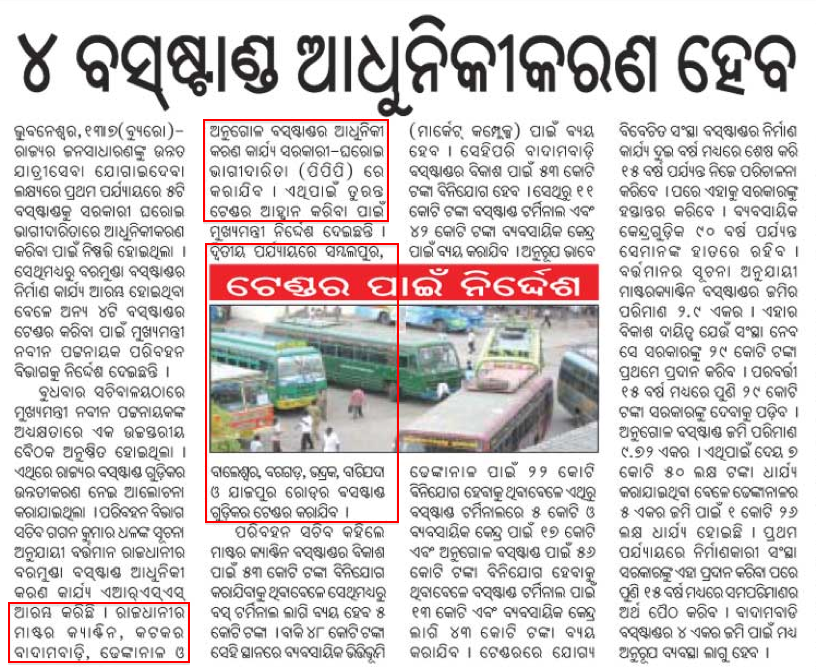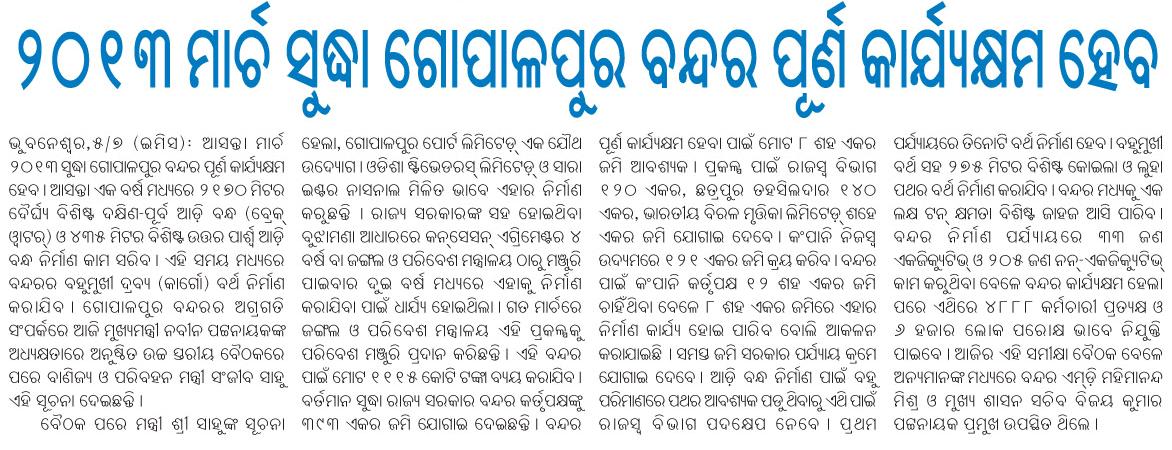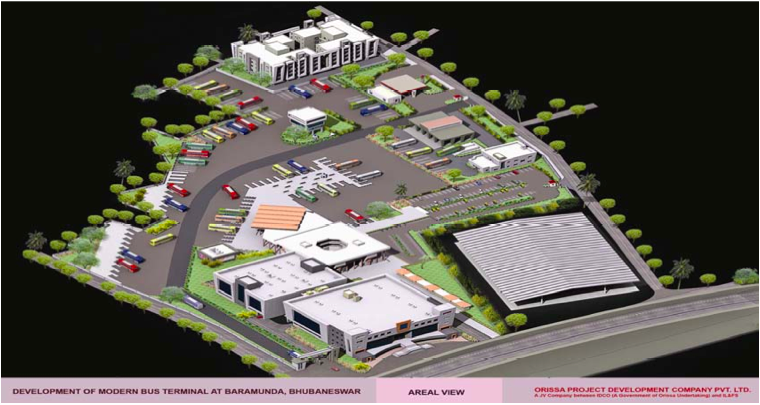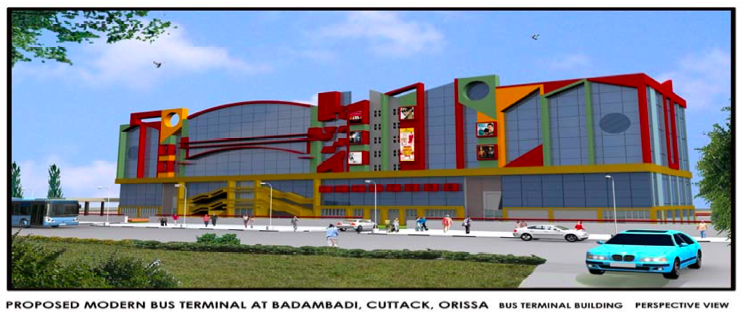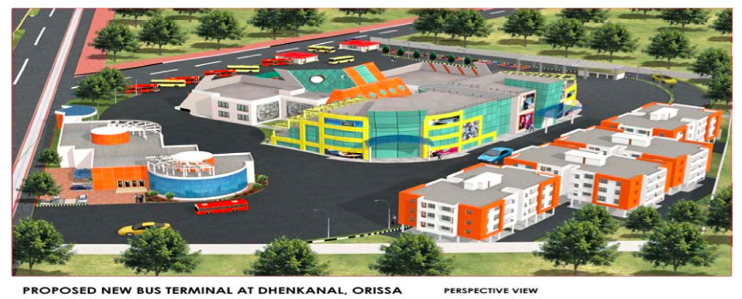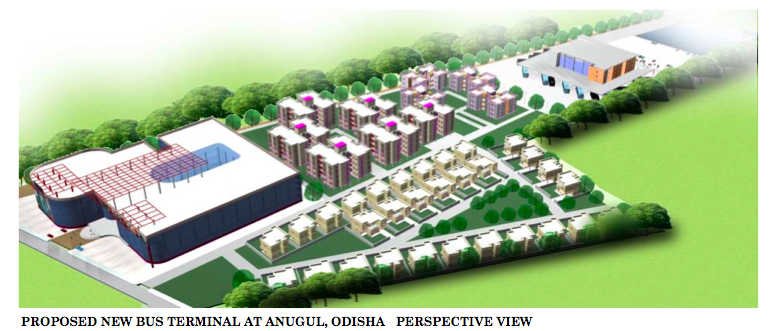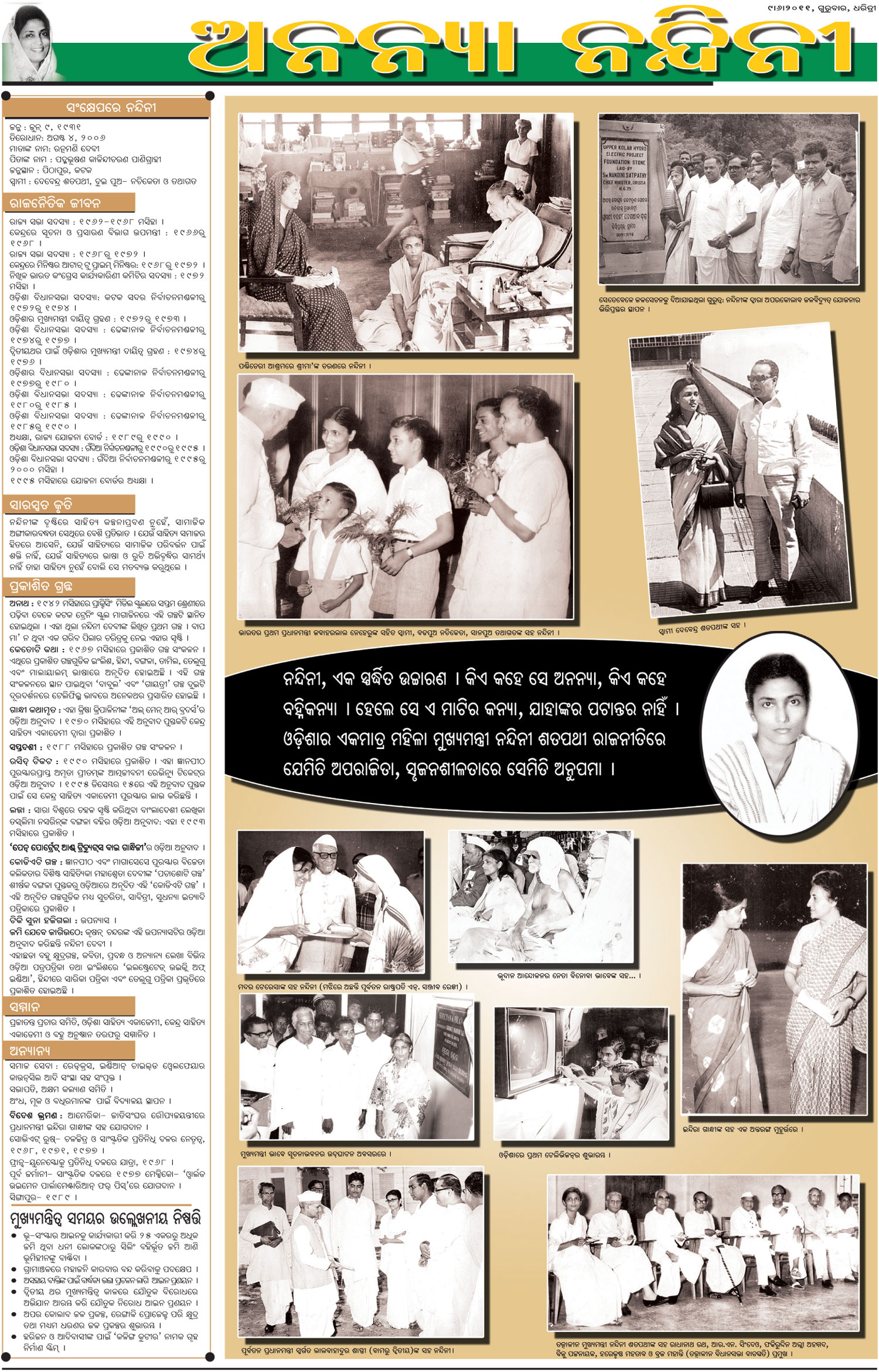Odisha’s first operational solar powerplant commissioned in Balangir district
Following is an excerpt from a report in Business Standard.
Hyderabad-based Raajratna Energy Holdings Private Limited (REHPL), a company engaged in the development of renewable energy projects has announced the commissioning of its 1 MW solar power plant at Sadeipali in western Orissa’s Bolangir district on last Monday.
Incidentally, this is the third grid connected solar power plant in the country. The plant was successfully synchronized with the grid on June 30 this year. This project has been commissioned in a record time of five months at an estimated cost of Rs 16-17 crore.
It has been implemented under the Jawaharlal Nehru National Solar Mission (JNNSM) of Rooftop PV (Photo Voltaic) and Small Solar Power Generation Programme (RPSSGP) Scheme of the Union ministry of New and Renewable Energy (MNRE).
The project was executed by AIC Projects GmbH, Germany and KSK Surya-Hyderabad. REHPL has expressed its gratitude to Rural Electrification Corporation Limited (REC) for its timely funding of the project.
To give a boost to solar power generation, Gridco had signed Power Purchase Agreements (PPAs) with eight solar developers, each with a capacity of 1 MW. It had also inked an MoU with Indian Renewable Energy Development Agency (IREDA) to avail generation based incentive (GBI) under the Union ministry of new & renewable energy (MNRE) through IREDA under Rooftop Photovoltaic and Small Solar Generation Programme (RPSSGP) scheme.
In addition to this, Gridco had also entered into power sale agreement with NTPC Vidyut Vyapar Nigam Ltd, a 100 per cent subsidiary of NTPC Ltd, to avail solar power bundled with equivalent capacity of thermal power from unallocated share of upcoming NTPC stations under ‘New Solar Projects’ scheme of MNRE. Under the said scheme, 20 MW of solar power has been allocated to Gridco.
Four laning of Sambalpur-Angul
Update on July 12 2011: As per a report in Business Standard:
The financial ministry approves the four laning of Angul-Sambalpur section of NH 42 in Orissa for Rs 1,220.32 crore and two/four laning of Birmitrapur to Barkote section in Orissa (Rs 778.15 crore). These are to be done via PPP.
Original part published on: June 19th. 2008, 11:55pm
Following is an excerpt from a report in New Indian Express.
The Lok Sabha petitions committee rapped the National Highway Authority of India (NHAI) for the inordinate delay in four-laning of the National Highway No 42 from Angul to Sambalpur. As a number of steel industries and thermal power plants are coming up in Jharsuguda, Sambalpur, Angul and Dhenkanal districts, traffic on this route has increased manifold. The State Government has been demanding the NHAI for further widening of this route in view of movement of large number of heavy vehicles. The petitions committee chaired by Pabhunath Singh met at Delhi recently and sought to know from the Ministry of Shipping, Road Transport and Highways about the delay in four-laning the road. The NHAI officials reportedly told the committee that the proposal of the State had been approved. After survey on traffic intensity on the route, the 107-km stretch between Manguli and Angul has been been identified for four-laning. The Ministry has made a budgetary provision of Rs 2.3 crore in the current year�s budget for feasibility study and preparation of detailed project report (DPR). Steps have been taken to engage a consultant for DPR preparation. … Dharmendra Pradhan, a member of the committee, reportedly suggested that the four-laning should be done up to Jarpada in view of the steel project coming up there. However, the Ministry officials said that there is no proposal for four-laning beyond Angul. On the development of 209-km-long NH-23 from Banarpal to Birmitrapur, the Ministry said that widening of 9- km road to two lane is in progress and the four-laning of Birmitrapur to Rajamunda depends of the traffic intensity. A consultant has been appointed for feasibility study.
IVF facilities in Bhubaneswar in the news
Update: See also http://timesofindia.indiatimes.com/city/bhubaneswar/Technology-propels-late-baby-boom/articleshow/9328807.cms. Following are some excerpts.
The twin cities of Bhubaneswar and Cuttack have around 50 fertility clinics offering various treatment options, apart from helping to procure donor eggs and sperms. "Most couples prefer their own donors for eggs and sperms though we also arrange them on demand from authorized agencies," said Dr Prabhat Nalini Mohanty, another fertility expert in Bhubaneswar.
"We can also help provide a surrogate mother if a family wants," said Dr Mohanty, who claims to have performed Orissa’s first surrogate delivery last year.
The cost of treatment varies from person to person depending on treatment options. "It can cost anything between Rs 50,000 to over a lakh. It depends on the woman’s condition," Mohanty said.
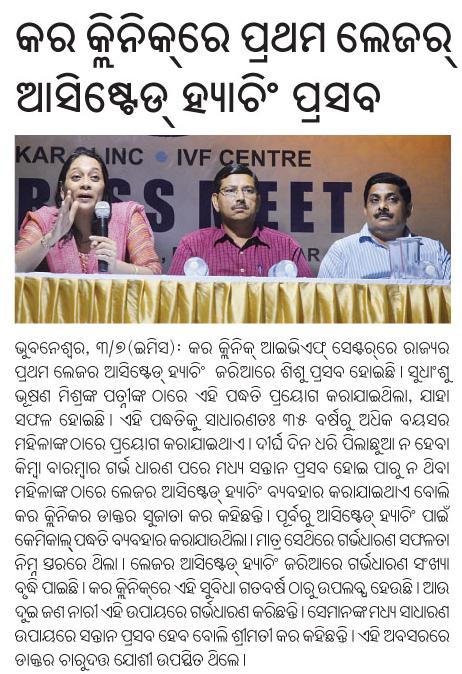
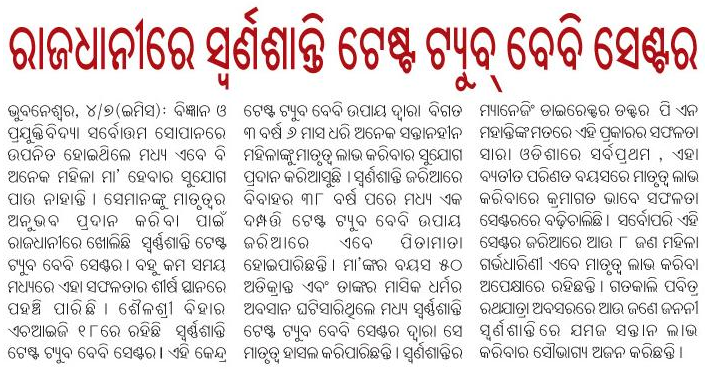
JSPL interested in setting up a captive port in Bahuda Muhana
Following is an excerpt from a report in Business Standard.
After committing investments on a new six million-tonne-per-annum (mtpa) steel plant, a captive power plant and a coal-to-liquid project in Orissa, Jindal Steel & Power Ltd (JSPL) has evinced interest on setting up a captive port in Ganjam district.
It involves a capital cost of Rs 1,424 crore, while the operational cost of running the port would be Rs 152 crore per annum. The first phase is scheduled to be operational by 2017.
The location is 30 km south of the existing Gopalpur port and 18 km from Berhampur.
JSPL today made a presentation to the state commerce and transport department on the proposed port at the mouth of the Bahuda river, a perennial port. The port does not require acquisition of farm land and there are no issues involved with nesting of the endangered Olive Ridley turtles in the area.
… The captive port will handle capesize vessels (150,000 or dwt) for coal and coke and Handymax vessels (50,000 dwt) for general cargo. During the first phase, the port will have two dedicated berths for handling coal and limestone and one berth for general cargo. The port is anticipated to handle about 33 million tonnes per annum of coal and other import items. Six capesize vessels of 150,000 dwt would make 36 visits each per annum for 33 mtpa of coal and other export items.
Work on the second phase is set to begin after 2017, when the port will have three more general berths.
By 2017, the port is expected to handle 4.93 million tonnes (mt) of steel coils and 900,000 tonnes of steel plates. Similarly, the company will import 5.5 mt of coking coal, 7.46 mt of non-coking coal, 2.6 mt of limestone and 3.7 mt of dolomite through this port by that period.
By 2020, the export of coils from the port is projected at 9 mt. Likewise, JSPL would import 12.6 mt coking coal, 7.5 mt non-coking coal, 4.4 mt limestone and 4.7 mt dolomite.
The multiplier effects of the port include revenue from cargo handling, regional economic development, and employment generation, development of road and rail connectivity and acceleration of local economy as well as that of the state.
Environment ministry clears 6 coal mining proposals in Odisha: PTI
Following is an excerpt from a PTI report in Times of India.
"All the six coal-blocks are part of the IB Valley coalfield and only one (Meenakshi-A) is presently in the ‘go’ area, the other five being in ‘no go’ areas. All six blocks will now be considered by FAC ( Forest Advisory Committee) as ‘go’ areas," Environment Minister Jairam Ramesh said in a statement.
Giving green signal to clear coal-blocks linked to UMPP, NTPC and OPGC power plants, the Minister said the Power Ministry should give "special focus" on ash disposal and water availability.
Three coal-blocks (Meenakshi-A, Meenakshi-B and Meenakshi Dipside) have been allocated to the 3960MW/4000MW Ultra Mega Power Plant (UMPP).
Coal-blocks (Manoharpur and Manoharpur Dipside) have been allocated to the 1320 MW power plant of Orissa Power Generation Corporation (OPGC). One coal-block (Dulanga) has been allocated to NTPC’s 1600 MW power plant.
CSE’s strong support to set aside 26 percent of net profits from mining to be shared with local communities
Following is from the article at http://www.cseindia.org/content/cse-releases-its-report-profit-sharing-mining. This is for wider dissemination of the article. The highlights are done by us.
Bhubaneswar, June 24, 2011: Mining companies and industry in general have been opposing the government’s recent proposal to set aside 26 per cent of their net profits, to be shared with local communities. Their contention is that this provision, if passed by Parliament, would drastically dent their profitability. A recent analysis by New Delhi-based research and advocacy body, Centre for Science and Environment (CSE), proves them wrong.
The Central government has come out with a draft Mines and Minerals (Development and Regulation) bill, 2010 (MMDR bill) to replace the 1957 Act. The draft bill which has been vetted by a GoM, includes this provision of sharing benefits. The CSE analysis comes out in strong support of this proposal, and clearly establishes how timely and necessary this provision is.
The CSE analysis was released here today in a Public Meeting chaired by Santha Sheela Nair, former secretary, Union ministry of mines. The meeting was attended by Manoj Ahuja, Secretary (Mines), Odisha government, BL Bagra, Chairman and Managing Director (NALCO) and Yashbant Narayan Singh Laguri, Member of Parliament (Keonjhar).
Speaking on the occasion, Chandra Bhushan, deputy director general of CSE said: "It is now well recognised across the world – including in India — that wealth generated by the mining sector comes at a substantial development cost, along with environmental damages and economic exclusion of the marginalised. In fact, the major mining districts of India are among its poorest and most polluted."
He added: "The government’s proposal to share the benefits of mining with local people is an important step ahead in building an inclusive growth model. It is also in line with the best practices being followed in the world. The principles are not new and many mineral-rich countries have been following it for years without impacting the genuine profitability of mining companies."
Profit sharing a global practice
To break this resource curse, a number of countries across the globe have incorporated the provision of benefit sharing in their mining legislations to enable local communities to benefit from mining activities in their region.South Africa’s Mineral and Petroleum Resources Development Act, 2002 gives communities the opportunity to obtain a ‘preferential right’ to prospect or mine a mineral on land registered under the name of the community.
In Canada, special mining regulations are in place to recognise the rights of the aboriginals. There are some treaties called land claim agreements (LCA) which establish defined area of land for aboriginals and cover issues of mineral rights. These agreements also give specific rights to aboriginals. For example, the Nunavut LCA grants Inuits the title to about 3.5 million ha of land and mineral rights to approximately 0.35 million ha. It also gives rights to Inuits in controlling how mining will proceed on lands owned by them. Usually in such circumstances, mineral leases are given to third party to develop those resources in exchange of signing an Impact Benefit Agreement (IBA). Even if both surface and subsurface right belongs to the government then also some rights like consultation are provided to aboriginals.
Papua New Guinea, for instance, has incorporated provisions under which the mine lease holder is to provide compensation to the landholders on whose land mining is to take place, under its Mining Act 1992. The compensation is dependent on the negotiating skills of the community/landholders. For instance, the Ok Tedi copper mines have a special institutional structure to manage and implement the 52 per cent dividends received from the mine operations. This is a legally binding obligation that the company must follow as per the legislation passed in November 2001.
In Australia, the aboriginals have been given special rights in case mining happens on their land. These rights are to be realised by mining agreements. Different parts of Australia, has varying laws regarding aboriginals and mining. For example, the Aboriginal Land Rights Northern Territory Act, 1976 establishes a financial regime whereby affected aboriginal people receive a share of the mining royalties earned from activity on aboriginal land. Australian government guarantee all mining royalty for aboriginal interests except 30 per cent which is reserved for the owners of the affected area.
Companies will lose profits? Hogwash
The CSE analysis clearly shows that the Indian mining sector enjoys huge profits. An analysis of the annual reports of three major non-coal mining companies (Manganese Ores India Ltd, Sesa Goa and National Mineral Development Corporation or NMDC) indicates that in 2009-10, their average profit after tax (PAT) was about 50 per cent of their turnovers. In the case of Coal India Limited, this was about 18 per cent.Assuming the draft MMDR Act, 2010 becomes a law, the CSE analysis of companies shows that it will not make any material difference to the profitability of the company. After sharing 26 per cent of the net profit with the affected community, the PAT of National Mineral Development Corporation – for instance — will still be 41 per cent of its turnover (from 55 per cent). In the case of Coal India Limited, PAT will become 14 per cent of its turnover from 18 percent.
Rich lands, poor people
Almost all the country’s minerals are located in regions that also hold most of its forests, rivers and tribal populations. Mining and quarrying has destroyed large tracts of forest land in these areas, affecting the ecosystem and the livelihoods of the already impoverished tribals.The top 50 mining districts of India, that account for more than 85 per cent of the value of minerals produced in the country (Rs. 85,00 crore), have close to 50 per cent of the total mine lease area in the country. These districts also have, on average more poverty, more forest cover and larger tribal population than rest of the country. According to CSE analysis, at least 2.5 million people are directly affected by mining in these districts which include those who have lost their land and livelihoods.
If the MMDR provision would have been implemented in the current year (2010-11), then the affected population of these districts could have got more than Rs 9,000 crore as share of profit from mining companies. The per capita figure for these districts could have been Rs. 38,000 in 2010-11 as share of profit from mining companies.
The mining affected people in Odisha would have got about Rs 1,750 crore as share of profit from mining companies. This could have been used to reduce hunger, provide better health and education infrastructure and to ultimately bring people out of poverty.CSE examines a few cases in the state: Keonjhar currently produces more than one-fifth of India’s iron ore and contributes more than Rs 7,000 crore to value of minerals produced in the country. Worse, mining has done nothing for Keonjhar’s economic well being. Over 50 per cent of the district’s population is below poverty line (BPL). If the draft MMDR provisions would have been implemented for the present year, the affected people of the district would have money to the tune of Rs 750 crore as profit share (2010-11 figures). Every BPL household in Keonjhar would have got at least Rs 40,000 annually.
Similarly, Sundargarh with Scheduled Tribes (ST) as about half its population, produces minerals worth Rs 2700 crore. The affected people of the district could get Rs 285 crore as share of profit from the mining companies. Every directly affected person from mining in Sundargarh could get Rs 45,000 annually.
Says Chandra Bhushan: “This money should be used not only to reduce present impoverishment but also for future well being of the communities like investment in health and education. There is huge opposition to this bill and it may get axed. It is very important for the communities that this bill goes through.”
For more information on this, please contact Sugandh Juneja of CSE at sugandh@cseindia.org or call her on 9953805227
For additional information on CSE’s work in this area and subject,
Recent steps on improving air-connectivity and airport infrastructure in Odisha
In the last couple of days there have been several news items regarding improving the air connectivity and airport infrastructure in Odisha. These include:
- Steps towards improving the current airport in Bhubaneswar.
- Steps towards expediting the Jharsuguda airport.
- Steps towards having air services to two additional airports in the state.
Following are some of the news items and excerpts.
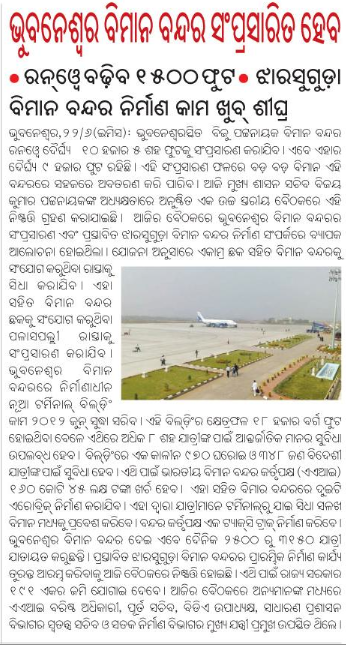
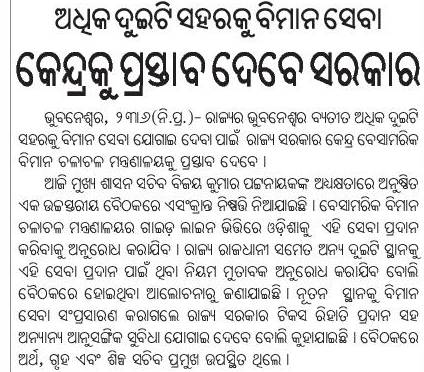
Odisha district-wise population and other 2011 census statistics
The following is from the Odisha datasheet at censusindia.gov.
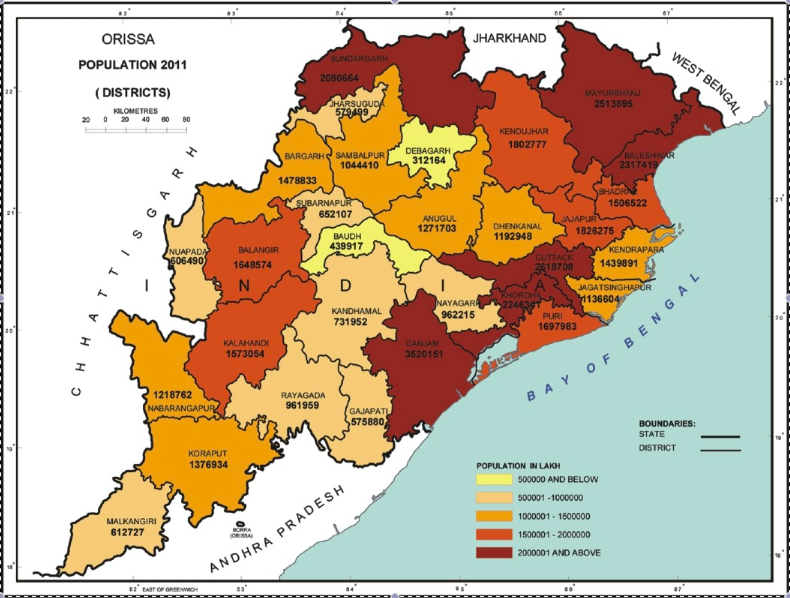
Based on the above map, the population of the Capital area consisting of Puri, Cuttack and Khurda districts is about 6.5 million. My guess is that if one draws a radius of 70 kms around the Bhubaneswar Secretariate-Assembly area, then the population of that would be between 5 to 6 million.
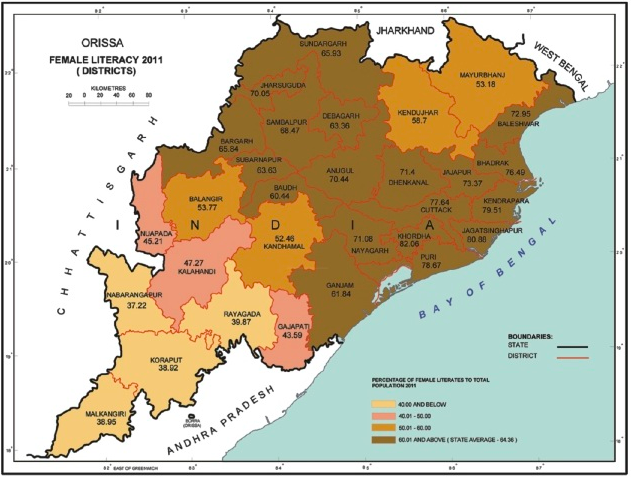
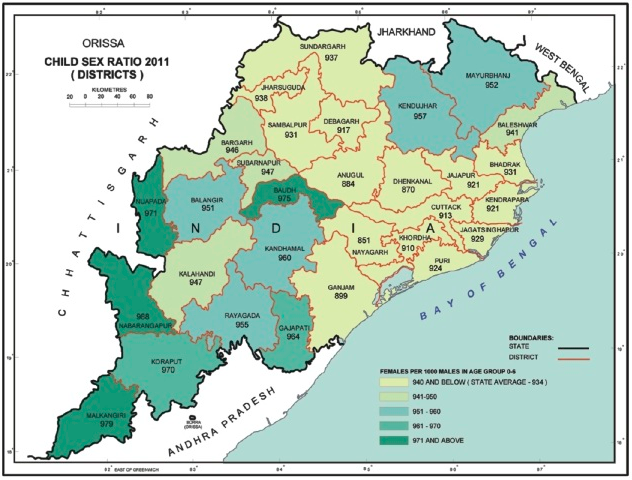
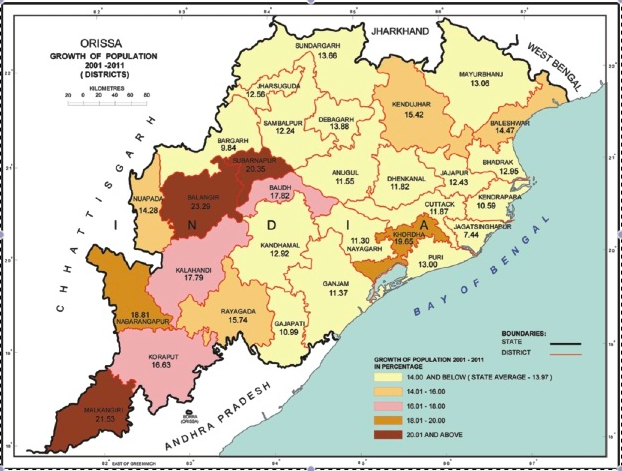
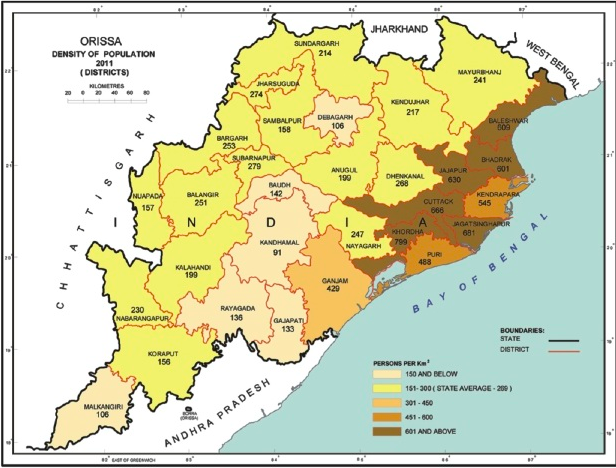
GDP of Odisha in comparison to other states
Following are snapshots from the page http://www.economist.com/content/indian-summary. (Note: I do not endorse or agree with these maps. These are just what the Economist website has.)
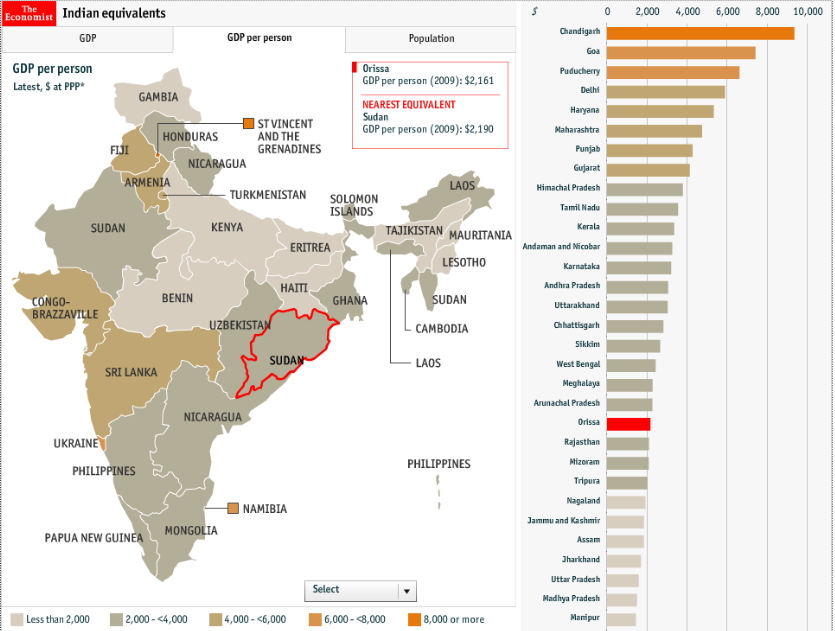
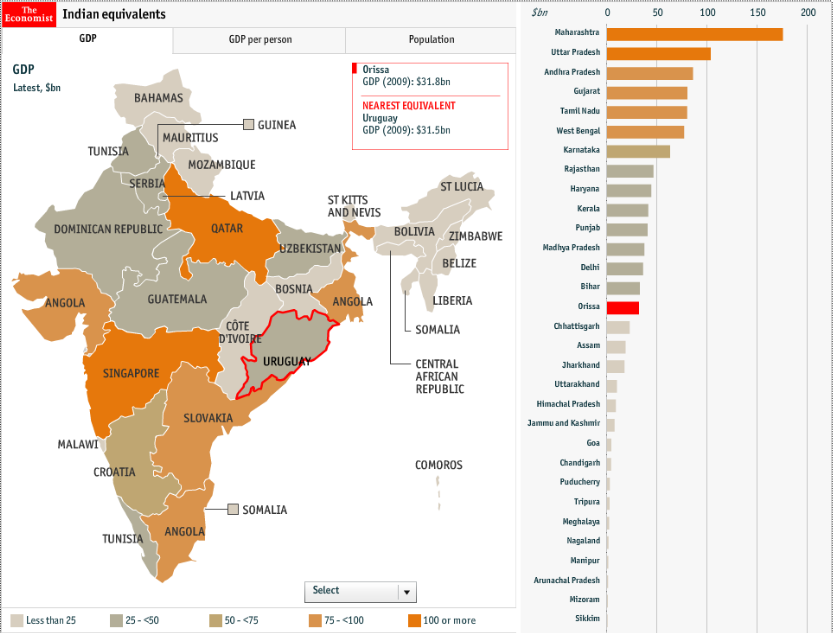
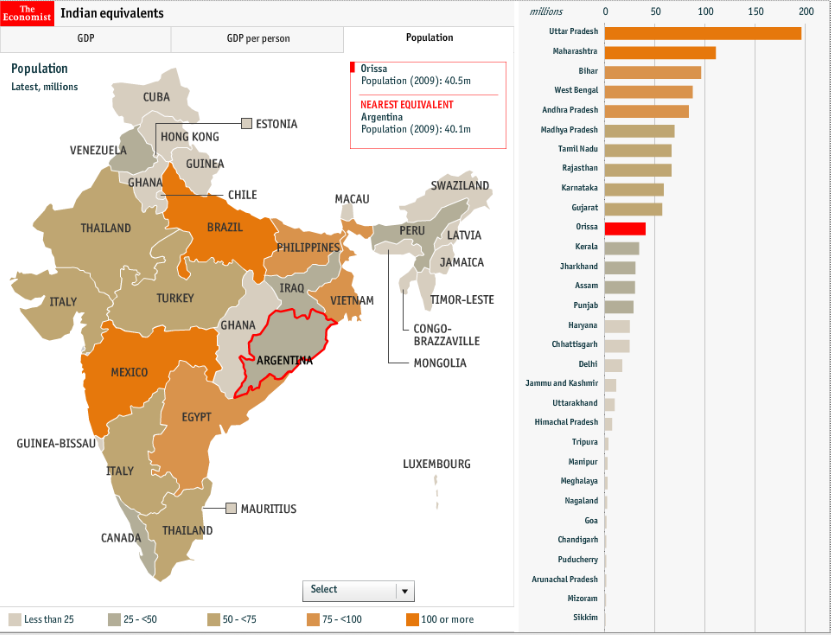
Odisha has attracted a total of 574 live investment projects worth Rs. 11.3 lakh crore as of December 2010; the count is 681 live projects as of today
Following is an excerpt from a report in Economic Times.
Orissa has attracted a total of 574 live investment projects worth Rs. 11.3 lakh crore as of December 2010, thus emerging as a lucrative investment destination.
The investment is heavily loaded in favour of manufacturing, power, mining, services, irrigation and real estate sectors according to an independent study of the Associated Chambers of Commerce and Industry of India ASSOCHAM.
The study titled ‘ASSOCHAM Strategy: Sustaining Growth Momentum in Odisha’ …"Registering a growth of over 19% year-on-year basis, Orissa has attracted 72 fresh live investment projects notching over Rs. 1.8 lakh crore as of December 2010 as against a total of 502 live investment projects worth Rs. 9.5 lakh crore as on December 2009," Mr Khaitan said.
Manufacturing sector has garnered lion’s share with almost 40 per cent in total investments, followed by power (37.8 per cent), mining (14.5 per cent), services (6.9 per cent) whereas, irrigation and realty sector have garnered a moderate share of 0.6 and 0.4 per cent respectively, according to the study.
Interestingly, while 51% of these live investment projects were in announcement stage, 45.9% of total outstanding investments were actually being implemented and only three per cent of aggregate investment projects were stalled due to obstructions, cancellations market policy, environmental clearances, land acquisition policy etc.
"Orissa has attracted almost 10% of total investments by both government and private sectors as on March 2010 attracting over Rs. 9.8 lakh crore out of total investment worth Rs. 105 lakh crore across India," Mr Dhoot added.
"Orissa accounted for merely 6% of total investments undertaken by various government agencies in India whereas; the state attracted around 12% of total investments by private sector across India. Besides, private sector accounted for over 70% of investments made in the state," Mr. Dhoot remarked.
ASSOCHAM has called for leveraging public resources to access private resources which would provide an environment to take advantage of liberalized policies.
"The state must restrict itself to the role of a regulator and a facilitator. Besides, public investments must be used for development of agri and allied sectors and development of secondary and tertiary sectors must be entirely left to private sector," Mr Rawat said.
Stating that Orissa’s share in subsidy granted from Viability Gap Funding (VGF) is way below other states, the ASSOCHAM called the state government to make optimum use of VGF for infrastructural development. It suggested for formation of a separate department to obtain central government’s support for infrastructural development. The industry body also called the state government to set up a Rs. 10,000 crore infrastructure development fund jointly with the central government.
Note that we mentioned in http://www.orissalinks.com/orissagrowth/archives/5004 the site http://www.business-beacon.com where one can find out the up-to-date list of live projects. As per that list, as of today Odisha has 681 live projects. But although that site gives the count of projects, it does not give free (not paid) access to find out the money amount.
The following excerpt from a different article in Economic Times illustrates the difference between the total number of projects and the total amount for those projects.
Karnataka ranks as number two top investment destination in the country after Gujarat with 1,528 projects worth Rs 9.1 lakh crore underway, according to industry body ASSOCHAM.
In Gujarat, 1,455 projects worth Rs 13.35 lakh crore are underway, ASSOCHAM officials said.
Nearly 44 per cent of the 1,528 projects in Karnataka are in manufacturing sector followed by 22.4 per cent in services, 15 per cent in power and about 14 per cent in real estate.
CMIE is a good source to find out about investement projects in Odisha and other states
Through the website http://www.business-beacon.com one can find out about the investment projects in India. Following the link http://www.business-beacon.com/kommon/bin/sr.php?kall=winv&tab=1040&prjby=cat&status=completed&catcode=1000000000000000 one can obtain the list of (i) Live, (ii) Completed, (iii) Abandoned/shelved and (iv) Announced and stalled projects for each of the states.
Early steps for a new airport in Bhubaneswar
Following are excerpts from a report in Times of India.
The city has moved a step closer to its dream of an international airport with the state government identifying over 2,000 acres of land, around 40 km south of the capital, on National Highway 5 for it. "We have identified over 2,000 acre near Jankia and Malipada villages. The survey work is on," Khurda collector Hrusikesh Tripathy said.
Sources said land of around 20 villages, including Gayabandha, Malipada, Dalaka, Pota and Godipada, a large tract of cashew plantation belonging to the Orissa State Cashew Development Corporation, are being considered for the proposed international airport.
Official sources said the area was considered for three main reasons. One, the government has a big patch of land available in the area. So the proposed airport would require minimum land acquisition and displacement. Secondly, the NH will provide good connectivity to the airport from the city. Thirdly, it will be a strategically located for Cuttack-Bhubaneswar urban complex as well as Puri and Berhampur.
…"The airport plan is futuristic keeping in mind the city’s need for 2030 and beyond. The location has to keep in mind the city’s needs then.
… Officials said the airport plan is still at a nascent stage. A committee under the revenue divisional commissioner (central range) has tentatively identified the land. After it finalises actual details of the land, the government would send the same for a feasibility study to the Airports Authority of India. If AAI gives it a go-ahead, the government would go for land acquisition. After that the government and AAI would involve private parties to develop the airport, they said. "The current airport almost divides the city into two. It is high time to consider shifting it to a new location," said BDA planning member Prashant Patnaik.
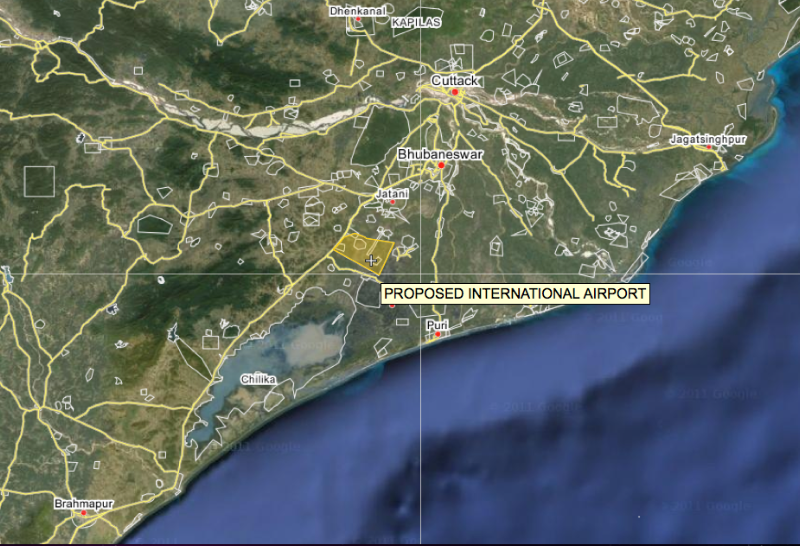
IDCO hands over 972 acres to OTDC for the Shamuka beach project
Following is an excerpt from a report in Business Standard.
The Industrial Infrastructure Development Corporation of Orissa (Idco) has handed over 972 acres of land to the Orissa Tourism Development Corporation (OTDC) for the Rs 3,500-crore Shamuka tourism project.
This was the land acquisition for the big-ticket project, to be set up over 3,000 acres near Sipasarubali, about 10 km south of Puri district.
… Till now, 11 professional consultancies have applied for the job. After the study report is prepared, the mode of implementation of the project will be decided. The options to implement the project are either through PPP (public-private participation) or joint venture, or forming a special purpose vehicle, sources said.
… The model plan for the project is ready. It has been prepared by the Centre for Environmental Planning and Technology.
The state government had lined up an investment of Rs 120 crore for developing external infrastructure facilities like water supply, electricity and roads for the project.
Integrated Coastal Zone Management Project (ICZMP) to cover renovation of heritage sites in Odisha; this includes upgradation of the state museum in Bhubaneswar
Following are excerpts from a report in Orissadiary.com.
… the Government of Orissa planned to renovate and conserve eight heritage properties currently in different stages of ruin, along the coast. This special initiative is a part of the Integrated Coastal Zone Management Project, which is being implemented in Orissa along with Gujrat and West Bengal with support from the World Bank.
… A special consultancy with funding support from with help from “Italian Trust Fund for Culture and Sustainable Development”, was undertaken to identify opportunities to promote local economic development connected to conservation of the built heritage and to promote linkages with conservation of traditional stone craft and enhancement of the State Museum at Bhubaneswar by LASA – INTACH consortium being facilitated by The World Bank.
… The eight significant heritage sites earmarked for restoration and tourism promotion are Bhaba Kundaleswar Temple of Manikpatna and Baliharchandi Temple in Puri district, Harihardeva Temple of Nairi in Khurda district, Potagada Fort, British Cemetry of Ganjam and Bateswar Temple of Kantiagada in Ganjam district, Jagannath Temple of Pentha and Jamboo Colonial Building in Kedrapara district.
… The preservation and restoration work would be implemented in next five years and Rs.7.41cr will be spent on this component as per the ICZMP plan. Preservation of cultural heritage and monuments along coastal stretch will be undertaken through the involvement of experts like LASA-INTACH. The work will undertake the structural conservation, chemical conservation, environmental up-gradation and illumination of the monuments. Primarily, the aesthetic and grand classic look of the monuments and the cultural sites will be maintained. Any contemporary work and intervention will be avoided to preserve the historical and physical integrity of the cultural property. The monuments are selected on the basis of their architectural, sculptural, historical and religious importance among the 160km coastal zone of the ICZMP pilot project area. …
BHABA KUNDELASHWAR TEMPLE at Manikpatna, Puri
The Shaivite temple is situated in Manikpatna village close to the new sea mouth of the Chilika Lake. The temple is a State protected monument and covered under Orissa Monuments Preservation Act, 1956. The temple is a part of a larger piligrimage route linked with the Jagannath temple at Puri. The temple marks the site of the blessing to the Gajpati Purushottamadeva on his famous Kanchi-Kaberi expedition. The legendary Manika, a milkmaid from the village, believed to offer curds to Lord Jagannatha and Balabhadra at the temple sites. The folk-lore suggests Lords are part of the royal army to bless the Gajpati.
HARIHARADEVA TEMPLE at Sanannairi, Khorda
This twin temple of Shiva and Vishnu is a State protected monument and covered under Orissa Monuments Preservation Act 1956. As the legend goes during the campaign of Kalapahar, the invader, when the Jagannatha temple at Puri was desecrated, the images are believed to have been brought here and hidden on an island, which is about 10minute boat ride away. They were also kept in the Harihar temple for some time.
POTAGADA FORT AND CEMETRY at Potagada, Ganjam
The construction of the unique star shaped fort was commenced in 1768 by Cotsword. The adjoining Cemetery contains interesting monuments in form of tomb stones. The French were the earlier settlers in this place who were later driven away by the British. The local folklore is that the site was under a curse and therefore an epidemic broke. The fort was surrounded by a moat.
The cemetery is one of the earliest one of British Administrators and comprise tombstones with spire like monuments in masonry.
HARCHANDI TEMPLE AT BALIHARICHANDI, Puri
The Shakti temple, 800meter away from the sea coast is under the State Preservation Act of 1956. The Bakiharichandi temple is 27km from Puri and linked through ritual and patronage, to the Jagannatha Temple complex at Puri. There are multiple stories about inception of this temple. The Goddess is believed to have killed Kalapahar at the temple spot. The temple also marks the spot where Indra’s Vajra, Shiva’s Trishul and his anger, in the form of the fire (Agni), as well as the wind and the sea come together.
OLD BUILDING at Jamboo, Kendrapara
The structure is a nineteenth century building that had been used for administrative purposes and cyclone shelter by the British.
STATE MUSEUM, Bhubaneswar
LASA –INTACH consortium; have developed the master plan of the State Museum with the inputs from the experts including the Italian experts. The inputs from Italy would certainly help to make our State museum world class.
Conclave Odisha: Unfolding Investment Opportunities

Life and times of Nandini Satpathy: From Dharitri
ASSOCHAM proposes 16 new PPP based clusters in Odisha
Following is from a report in Economic Times by Nageshwar Patnaik.
The Associated Chambers of Commerce and Industry of India (ASSOCHAM) on Wednesday proposed setting up of 16 new clusters on public-private partnership [PPP] in Orissa each accommodating about 1000 units and providing direct and indirect employment close to 4 lakh people.
Releasing the ASSOCHAM study on "Cluster Development for Inclusive Growth in Orissa" National Secretary General, D. S. Rawat said, "The total funds required for basic and essential infrastructure to these clusters will be about Rs. 480 crores. Once functional, it will contribute additional 10% revenues per annum to the exchequer, help in inclusive growth and simultaneously lead to upgradation of existing clusters.
… In the state, there are only 26 clusters in the state recognized by the Central government as against 6500 clusters in the country out of which 450 are assisted by the government. The 16 new clusters suggested by ASSOCHAM are: Palasa (Cashew), Buditi (Brass & Bell Metal), Baripada (Sabai Grass), Dhenkanal (Powerloom), Puri (Rice Mills), Bhadrak (Rice Mill Cluster), Dhamara (Ice Plant), Basudevpur (Ice Plant), Chandbali (Chuda Cluster), Tihdi (Chuda Cluster), Basudevpur (Chuda Cluster), Bhandaripokhari (Honey), Dhamara (Honey), Betaligaon (Wood Carving), Olaga (Wood Carving) and Dhusuri (Wood Carving).
The MSME sector contributes around 40% to GDP with an estimated value of goods and services around Rs. 20 lakh crore in 2009-10. The sector is estimated to employ about 5.9 crore people in over 2.6 crore units in the country and has consistently registered a higher growth rate than the rest of the industrial sector. There are over 6000 products ranging from traditional to high-tech items, which are being manufactured by the MSMEs in India.
Odisha government plans to turn its three medical college hospitals to super-speciality hospitals
Following is an excerpt from a report in ibnlive.com.
The State Government on Tuesday announced creation of 669 new doctor and para-medical staff posts along with an addition of 869 beds in its three medical college and hospitals.
Four new departments have been notified for the SCB Medical, Cuttack, and two each for MKCG, Berhampur, and VSS, Burla.
The move marks the beginning of efforts by the Government to increase the MBBS seat strength in the three medical colleges from the present 150 to 250.
The process of assessing infrastructure, faculty and other capacities along with identifying the areas that need attention in the medicals so as to get the approval of the Medical Council of India (MCI) has started. A detailed proposal would be sent to the MCI soon, sources said.
Health Minister Prasanna Acharya on Tuesday said 478 beds would be added to 1,200-bed SCB along with 40 doctors and 126 para-medics, including nurses.
Four new departments in Transfusion Medicine, Emergency Medicine, Rheumatology and Hepatology have been announced.
Three professor, 11 associate professor and 34 senior resident posts have been created.
The MKCG would have 181 more beds with two new departments in Transfusion Medicine and Emergency Medicine.
The new posts include two professors, four associate professors, 12 assistant professors, 39 senior residents, 105 staff nurses, 10 nursing sisters, one assistant matron and 15 attendants.
The VSS has been infused with 210 new beds and two departments on Transfusion Medicine and Emergency Medicine. New posts include two professors, five associate professors, 22 assistant professors and 37 senior residents.
Shimla, Jamnagar and Bhubaneswar have been selected to participate in the Asian Cities Climate Change Resilience Network – Dissemination & Replication (ACCCRN-D&R) project
ICLEI stands for ‘International Council for Local Environmental Initiatives’. Following is from a recent announcement.
Three Indian Members selected for Dissemination & Replication stage of ACCCRN project
May 02, 2011ICLEI South Asia is pleased to announce that three Indian cities, Shimla, Jamnagar and Bhubaneswar, all ICLEI Members, have been selected to participate in the Asian Cities Climate Change Resilience Network – Dissemination & Replication (ACCCRN-D&R) project on the basis of an Expression of Interest that was circulated to over 35 Indian cities.
The ACCCRN is made up of ten cities in India, Indonesia, Thailand and Vietnam, currently experimenting with various adaptation activities that together aim to improve the ability of these cities to withstand and prepare for the projected impacts of climate change. The ultimate objective of ACCCRN is to provide poor and vulnerable people with the ability to respond to these impacts in an appropriate way.
In order to achieve this, the program partners have developed a diverse range of effective approaches, processes, and practices to build urban climate change resilience which incorporate the priorities of poor and vulnerable communities in the network’s cities.The approaches taken are determined by the local needs and priorities of each city.
Initiated in early 2009, with support from the Rockefeller Foundation, the first two phases of the project have been completed. The third phase has now been launched with a focus on disseminating and replicating the lessons learnt and the approaches developed in the previous phases.
In this third phase, the learning, models, approaches and best practices developed across the 10 pilot cities of the previous phases will be supplemented with best practices from other approaches which build urban climate resilience. This will all be developed into a tool that can be adopted by other cities to develop Climate Resilience Strategy Plans. ICLEI’s South Asia and Oceania offices have been commissioned to implement the third phase of ACCCRN in the three Indian cities.
Read more about the project on the ICLEI South Asia website.
Following is from http://www.iclei.org/index.php?id=12113 about the project.
As part of the Dissemination & Replication phase, a total of 3 Indian cities have be selected for the dissemination of this tool. The selected cities would receive training in the process of formulating Climate Resilience Strategy Plans, which would broadly include:
1. Undertaking vulnerability assessments
2. Undertaking climate projection assessments
3. Engaging stakeholders in the entire process to ensure social relevance and acceptance
4. Developing a Climate Resilience Strategy Plan document
5. Integrating the resilience strategy into urban planning and implementation processesICLEI SA along with ICLEI Oceania and ISET will replicate the learnings from the previous phases of ACCCRN initiative in 3 other cities. The various interventions are expected to target sectors like health, infrastructure, water, disaster, urban planning/development issues, services, disaster management and preparedness strategies.
The approach followed in the cities will be driven by local needs and requirements with the focus on developing resilience for the vulnerable communities from climate change impacts. ICLEI SA has been engaged to assist develop the methodology in a form suitable for the Indian context and to select and support the Indian cities during the trial period.
